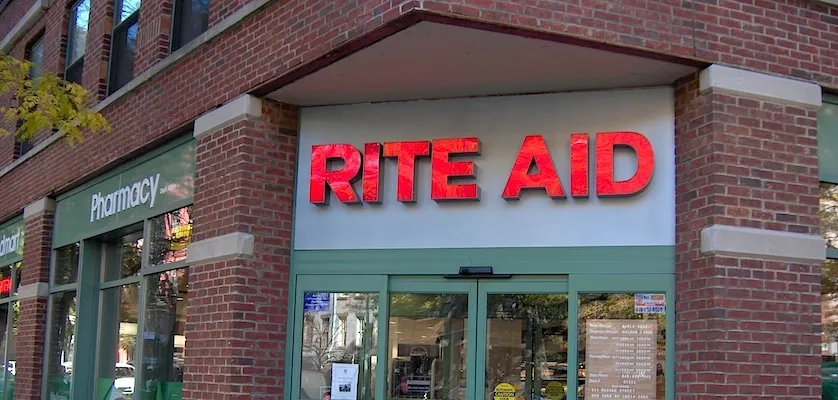CAMP HILL, Pa. — Rite Aid Corp. reported declined sales and adjusted earnings per share in line with Wall Street’s forecast for its fiscal 2018 second quarter.
Rite Aid said Thursday that for the second quarter ended Sept. 2, revenue totaled $7.68 billion, down 4.4% from $8.03 billion a year earlier.
Sales in retail pharmacy segment fell 3.4% to $6.27 billion from $6.49 billion a year ago, which Rite Aid attributed mainly to decreased same-store sales and reimbursement rates. Pharmacy services segment sales came in at $1.49 billion, down 8.7% from $1.63 billion in the prior-year period, because of an election to participate in fewer Medicare Part D regions, the company said.
Same-store sales for the quarter declined 3.4%, reflecting decreases of 0.9% in the front end and 4.6% in the pharmacy. Comparable pharmacy sales included a negative impact of 189 basis point from introductions of new generic drugs. Prescription count, adjusted to 30-day equivalents, dipped 1.8% year over year, which Rite Aid said was due in part to exclusion from certain pharmacy networks that it participated in a year ago.
Second-quarter net income totaled $170.7 million, or 16 cents per diluted share, compared with $14.8 million, or 1 cent per diluted share. Rite Aid said the improvement in operating results stemmed from the receipt of a $325 million fee from Walgreens Boots Alliance Inc. for the termination of its acquisition agreement, partially offset by a decline in adjusted EBITDA (earnings before interest, taxes, depreciation and amortization) nd higher income tax expense.
Rite Aid posted an adjusted net loss of $15.6 million, or 1 cent per diluted share, in the quarter versus adjusted net earnings of $36.4 million, or 3 cents per diluted share, in the fiscal 2017 quarter. The company attributed the decrease to a decline in adjusted EBITDA, partially offset by reduced adjusted income tax expense and depreciation and amortization expense.
Analysts, on average, had projected an adjusted net loss of 1 cent per share, with estimates ranging from a low of a 1-cent net loss to a high of EPS of 5 cents, according to Thomson Reuters.
Adjusted EBITDA for the second quarter was $213.3 million, or 2.8% of revenue, compared with $312.7 million, or 3.9% of revenue, a year earlier. Rite Aid said the decline reflects a $98.6 million decrease in the retail pharmacy segment, which was primarily driven by reduced pharmacy gross profit from narrower reimbursement rates. The company noted that it wasn’t able to fully offset that negative impact with generic purchasing efficiencies and lower script counts, but good cost control provided a partial offset. Adjusted EBITDA in the pharmacy services segment came in flat for the quarter.
“While our performance for the quarter reflects a challenging reimbursement rate environment and the effects of an extended merger and asset sale process, securing regulatory clearance for the amended asset sale agreement with Walgreens Boots Alliance gives us a clear path forward to realize the benefits of the transaction and implement our plans to deliver improved results,” Rite Aid chairman and chief executive officer John Standley said in a statement.”
Over a week ago, WBA and Rite Aid announced that the Federal Trade Commission approved an agreement for WBA to acquire 1,932 stores, three distribution centers and related inventory from Rite Aid for $4.375 billion. That was down from a deal unveiled June 29 in which WBA would buy 2,186 stores as well as the three distribution centers and related inventory from Rite Aid for $5.175 billion. The companies also said that day they were terminating the planned Walgreens-Rite Aid merger, which had been under review by the FTC for almost two years. With the decision, WBA had to pay Rite Aid a $325 million termination fee cas alled for by the initial merger agreement.
“As we work to complete the asset sale, which will reduce our leverage and provide greater financial flexibility to invest in our business, we’ll also focus on generating momentum for our business by meeting the health and wellness needs of our customers and patients while delivering an outstanding experience in our stores,” Standley noted.
During the second quarter, Rite Aid opened one store, relocated one store, remodeled 54 stores and expanded one store, bringing the total number of Wellness format stores to 2,532. The company closed 17 stores, giving it a store count of 4,507 as of the quarter’s end.
“In addition, we’ve announced this morning that Kermit Crawford — a proven leader with extensive retail pharmacy experience — is joining Rite Aid as president and chief operating officer to further strengthen our leadership team,” Standley added.
Crawford, formerly corporate executive vice president as well as president of pharmacy health and wellness at Walgreen Co., is expected to bring deep pharmacy and health care expertise as well as strong management experience, Rite Aid said.






